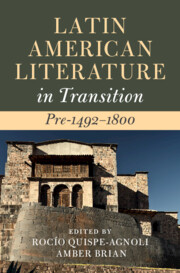Book contents
- Latin American Literature in Transition Pre-1492–1800
- Latin American Literature in Transition
- Latin American Literature in Transition Pre-1492–1800
- Copyright page
- Dedication
- Contents
- Figures
- Contributors
- Acknowledgments
- Introduction Dwelling in Transitions
- Part I Land, Space, Territory
- Part II Body
- Part III Belief Systems
- Part IV Literacies
- Part V Languages
- Part VI Identities
- Chapter 22 Textual Figures and Modalities of Change: The Soldier, the Translator, the Plebeian, and the Woman Chronicler
- Chapter 23 Diego Muñoz Camargo and the Destabilization of the Relación Geográfica: Adaptation and Variation in the Mestizo Chronicle
- Chapter 24 Representing/Erasing the Other in Colonial Brazil’s Eighteenth-Century Epic Poetry
- Index
- References
Chapter 23 - Diego Muñoz Camargo and the Destabilization of the Relación Geográfica: Adaptation and Variation in the Mestizo Chronicle
from Part VI - Identities
Published online by Cambridge University Press: 25 November 2022
- Latin American Literature in Transition Pre-1492–1800
- Latin American Literature in Transition
- Latin American Literature in Transition Pre-1492–1800
- Copyright page
- Dedication
- Contents
- Figures
- Contributors
- Acknowledgments
- Introduction Dwelling in Transitions
- Part I Land, Space, Territory
- Part II Body
- Part III Belief Systems
- Part IV Literacies
- Part V Languages
- Part VI Identities
- Chapter 22 Textual Figures and Modalities of Change: The Soldier, the Translator, the Plebeian, and the Woman Chronicler
- Chapter 23 Diego Muñoz Camargo and the Destabilization of the Relación Geográfica: Adaptation and Variation in the Mestizo Chronicle
- Chapter 24 Representing/Erasing the Other in Colonial Brazil’s Eighteenth-Century Epic Poetry
- Index
- References
Summary
This chapter explores the historiographical project developed by the sixteenth-century mestizo chronicler Diego Muñoz Camargo, son of a Spaniard and a Native woman from Tlaxcala in New Spain. His project develops in three iterations and in each version tells the history of his mother’s ethnic group: Descripción de la ciudad y provincia de Tlaxcala (1584), Suma y epíloga de toda la Descripción de Tlaxcala (1588-1589) and Historia de Tlaxcala (1592). This essay looks at how Muñoz Camargo’s three-stage project responded to, in varying ways, the 1577 relación geográfica questionnaire that was devised by the imperial powers to learn about and better control the subjugated regions in the New World. Muñoz Camargo sought to insert the non-European history of Tlaxcala in a colonial Spanish narrative framework.
Keywords
- Type
- Chapter
- Information
- Latin American Literature in Transition Pre-1492–1800 , pp. 348 - 361Publisher: Cambridge University PressPrint publication year: 2022

